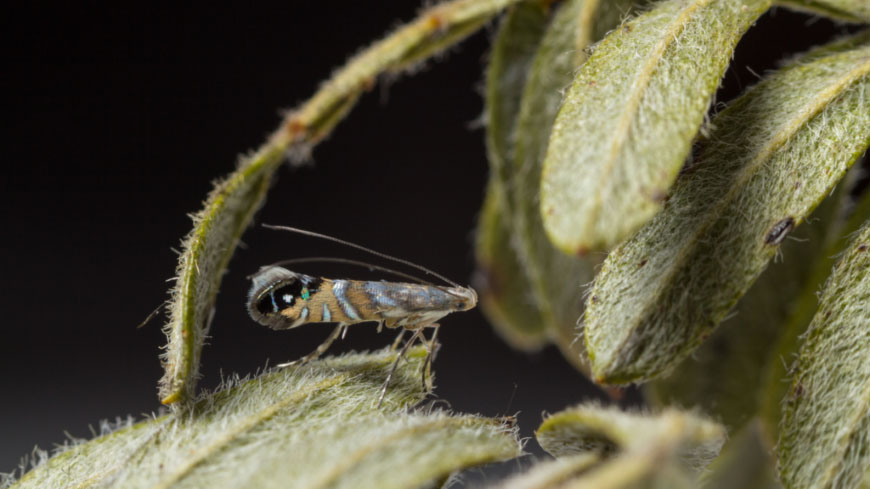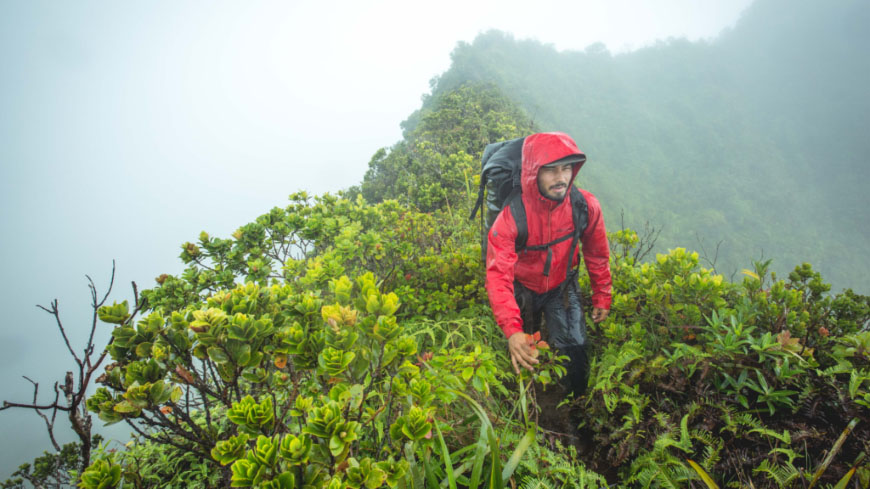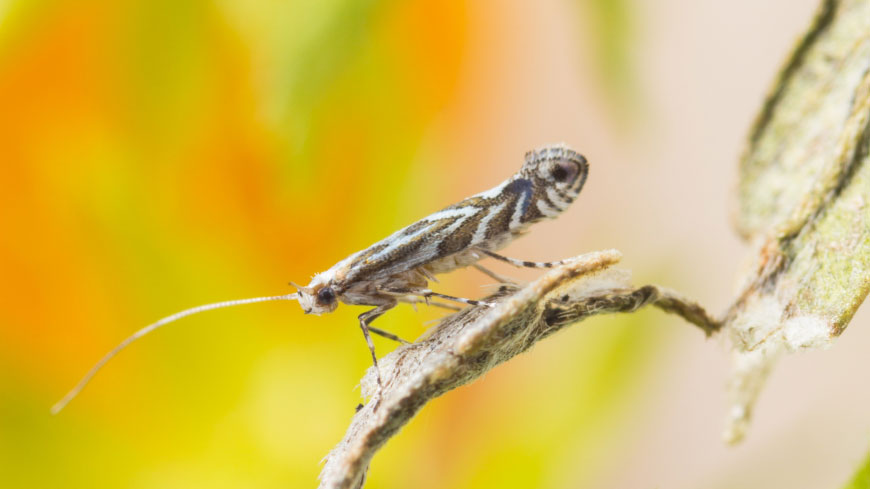By Jon Letman, Editor

The Hawaiian Islands are often associated with big, dramatic natural events (volcanic eruptions, powerful ocean swells) and large, complex ecosystems (dense tropical forests, dynamic coastlines), but it’s Hawaii’s earliest, smallest, least known creatures that offer one of the most important lessons about evolution, diversity, and interdependence.
Hawaii is home to a genus of micromoth called Philodoria which is believed to have first reached the Hawaiian Islands 21 million years ago (some 8 million years before Hawaiʻi’s largest plant clade, the Lobeliads). Like the larvae of some beetle and fly species, Philodoria are leaf miners. They’re also extremely small — about as long and as thick as a human eyelash.
When the tiny moth lands on the leaf of its host plant, it lays eggs which produce microscopic caterpillars that burrow through the leaf, forming tiny tunnels and caverns as they eat their way through the tissue of their thin, green home. There they grow into larvae safely sheltered from predators like parasitoid wasps which are known to use Philodoria larvae as a host.
After several weeks, the caterpillar grows until it pupates, emerging from the leaf in a cocoon before metamorphosizing into a moth. The whole process takes up to six weeks.
Survival of the Philodoria, which are endemic to Hawaii, depends on the moth-host plant relationship. If the host plant goes extinct, it stands within reason that the moths that depend on them will disappear too.

Earlier this year, researchers from Osaka Prefecture University and the Florida Museum of Natural History (University of Florida) published a monograph (in depth study) with names, descriptions, and the conservation status of 13 new Philodoria species and their host plants. In total, researchers confirmed 51 Philodoria species, many of which hadn’t been seen in over a century, and 13 of which were new to science.
Among the newly described moths, Philodoria limahuliensis, is known from a single location in the Upper Limahuli Preserve. Biologist Dr. Chris Johns, a co-author of the paper, first saw the moth in 2016. Johns, a self-described micromoth enthusiast, says even this tiny creature plays an important role in the ecosystems they inhabit.
Studying Philodoria can help us understand many other forms of life, including our own, says Johns. “Philodoria moths can teach us a lot of things about life on this planet and evolution.”
When Johns teamed up with entomologist Dr. Akito Kawahara at the University of Florida in 2013, Philodoria hadn’t been studied closely in over a century and their conservation status was poorly understood. Johns, who had previously done conservation work in Hawaiʻi, jumped at the chance to join Kawahara for what would be a five-year study searching for some of the world’s smallest moths inside of the world’s rarest plants.
Over the course of six trips to six Hawaiian islands, Johns partnered with local scientists to search for Philodoria living among host plants including ohia (Metrosideros spp.), mamaki (Pipiturus spp.), and Hesperomannia, an extremely rare native member of the sunflower family. As a genus, Philodoria are diverse feeders though they tend to develop a very specific host plant relationship. One species lives among Wollastonia integrifolia, a coastal plant, while another lives within the greenswords (Argyroxiphium grayanum) of west Maui’s high elevation bogs where it was described as Philodoria wilkesiela by English entomologist Lord Thomas de Grey Walsingham in 1907. Johns found the same moth in that exact location in 2013. Philodoria’s historical range has been well-documented, Johns said, but it was difficult to find intact habitat that hadn’t been developed or entirely replaced by invasive species.
In 2015, based on Kawahara’s past collaboration with NTBG staff, Johns was introduced to then-NTBG field collector Natalia Tangalin, from whom he learned of known leaf miners suspected to be Philodoria in the Limahuli Valley. That year Johns and Tangalin helicoptered to a weatherport (in the Upper Limahuli Preserve to provide shelter for multi-day fieldwork) in the Upper Limahuli Preserve. Based on a hunch from Tangalin, they hiked down to a place where a small stream flows into a waterfall. Just above that spot, a lone shrub — Hibiscus waimeae subsp. hannerae — grew out of a sidewall in the stream. There they collected ten moths which Johns believes were unique to the location and to date is the only known habitat of what has been named Philodoria limahuliensis. Johns says P. limahuliensis is one of the rarer species but a second Philodoria species was found in Limahuli Valley living with its host ohia (Metrosideros sp.).

Some might question the significance of finding a tiny moth on a Critically Endangered plant in the back of a remote valley. Johns explains how such a discovery sheds light on the origin and age of organisms in Hawaii, a place that has informed much of our scientific understanding of evolution on islands. Philodoria may be the oldest extant lineage in the archipelago. “As far as things that remain alive in Hawaii today, Philodoria seems to be one of the first to get here,” Johns says.
And because, like the Galapagos, Hawaii is a storied natural laboratory for evolution, identifying a new micromoth found nowhere else on earth opens a new chapter of scientific inquiry and can address the same questions asked about other organisms, offering a new perspective and more comprehensive understanding of evolution and life on earth.
To study an insect as small as Philodoria, scientists must go to great lengths to identify and understand how species are related to one another. One method of identification is a morphological examination of the genitalia of each species which is challenging given the moth’s size. Another technique is the molecular analysis of tissue to compare DNA among differing species.
Using phylogenetics and a technique called ancestral reconstruction (DNA analysis to understand how species are related to one another), Philodoria researchers have gained new insights to what ancient moths might have been feeding on when they inhabited now sunken Hawaiian Islands that predated the islands we know today. Johns says it’s likely those ancient host plants belonged to Ebenaceae, Malvaceae, and Primulaceae. “That paints a really interesting picture of something we didn’t know before about this place,” Johns says.
Even for the non-scientist, Johns says people are drawn to anything that creates a deeper, more complex picture of a place revered for its natural beauty. “What is it that comprises that natural history?” he asks. “It’s biodiversity. Who doesn’t love a new angle to a beloved story or character?”
The discovery of Philodoria limahuliensis near a small waterway that feeds into the Limahuli Stream underscores the importance of protecting and studying this pristine riparian habitat. The unique conditions found along the stream led to an NTBG-led project to restore the health and function of the stream. Selective tree trimming, outplanting, and extensive monitoring are expected to benefit native flora and fauna while helping preserve whole-ecosystem biodiversity in the Limahuli Valley.
Having found and identified Philodoria limahuliensis in the Limahuli Valley, Johns was elated to have had the chance to work in a native forest that remains largely intact and relatively weed-free. He calls Limahuli “among the very best of privately held land with robust environmental protection” in Hawaii.
“NTBG has something really, really, really special,” Johns says. “In terms of moth diversity and the potential for future discovery and protection… Limahuli is one of the best places. I think the work that’s being done there is top notch.”